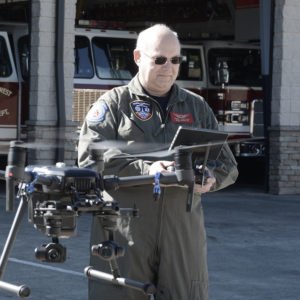 In this column, Steve makes sure drone pilots know how to be compliant with Part 107 visual line of sight (VLOS) requirements.
In this column, Steve makes sure drone pilots know how to be compliant with Part 107 visual line of sight (VLOS) requirements.
The following is one of an educational series for drone pilots by Steve Rhode, Chief Pilot with the Wake Forest Fire Department and the North Carolina Public Safety Drone Academy, and founder of Public Safety Flight, a website dedicated to information about the use of unmanned aircraft systems (UAS), UAVs, aircraft, and drones in public safety. (Not to be contrued as legal advice: please see details at the FAA government site. Opinions are the author’s.)
As an FAA certificated pilot since 1988, I’ve learned one lesson that everyone should accept to be a better aviator; you are never going to know it all, but you have to make an effort to keep learning.
I’m regularly trying to educate new drone pilots through my site Public Safety Flight. So it seems as not a day goes by that, I’m not answering a recent reader question that leads me to learn something new in the drone world.
I’m lucky that I’ve made great friends and contacts at the FAA that allow me to ask impossible questions. I’m fortunate that I love research and reading long boring government documents to find the answers. I feel honored to be a Drone Pro on the FAA FAASTeam.
But with all of that going for me, I’m honestly always learning something new and still having those “Oh Crap” moments when I realize the existing regulations do not support yet another belief.
You will often find I link to the FAA authoritative resource or quote it in my answers to show you the facts. I’ve learned never to assume anymore.
Most Pilots Seem to Go Through Phases
New Pilots: Know it all. They’ve passed whatever exam is necessary, and they embark with supreme confidence being newly minted. I shudder now at my freshly minted confidence as I obtained my ratings, manned and unmanned.
Pilots With Some Flight Time: The moment you comprehend you don’t know that much is humbling. You’ll learn yet another aviation lesson the hard way. Hopefully, sooner rather than later, there will be a time when you realize your assumptions are not based on the existing regulations but what you heard someone else say. You begin to question everything you think you know, and this is when you start to learn.
Experienced Pilots: Many of these pilots realize they don’t know it all and are always learning. So there is an expression: There are old pilots and bold pilots but no old bold pilots. In the manned world, pilots taking stupid risks tend to kill or injure themselves or others. In the drone world, the potential consequences for taking unnecessary uneducated risks are death or injury to someone on the ground and pilots that will get sued or fined out of their financial future. That might sound ridiculous until you realize that it’s not.
Regulation and Logic are Not Bedfellows
There are so many quicksand fields you can’t see but might fall into in the drone world. For example, you read an advertisement that proclaims a magic product. Advertising is selling. Regulations are laws or rules with consequences. They are two completely different things.
Here is one assumption some have had: I can extend my flight range by daisychaining Visual Observers (VO) that can maintain Visual Line of Sight (VLOS) of the aircraft.
The FAA addressed this issue in 2015 by saying, “Since the operator and any visual observers would be required to be in a position to maintain or achieve visual line of sight with the aircraft at all times, the proposed rule would effectively prohibit a relay or “daisychain” formation of multiple visual observers by requiring that the operator must always be capable of seeing the small unmanned aircraft. Such arrangements would potentially expand the area of a small UAS operation and pose an increased public risk if there is a loss of aircraft control. ” – Source
Ask Questions
To strive to become a professional drone pilot and maintain your knowledge, the best thing you can do is find a source of information you can trust and rely on for factual and authoritative answers, not assumptions and guesses.
One place to hunt down an authoritative answer is to contact your local FAA Flight Standards District Office. You can also reach out to the FAA UAS staff here.
But I’m always here to help, don’t be shy about asking me if you have a question about Part 107 or public safety COA flight. I’ll dig into it, hunt down the answer, and share it in an upcoming column so we can all learn from it. So click here and ask away.
Read more from Steve Rhode: Part 1, VLOS flight at night; public safety crash highlights.
Miriam McNabb is the Editor-in-Chief of DRONELIFE and CEO of JobForDrones, a professional drone services marketplace, and a fascinated observer of the emerging drone industry and the regulatory environment for drones. Miriam has penned over 3,000 articles focused on the commercial drone space and is an international speaker and recognized figure in the industry. Miriam has a degree from the University of Chicago and over 20 years of experience in high tech sales and marketing for new technologies.
For drone industry consulting or writing, Email Miriam.
TWITTER:@spaldingbarker
Subscribe to DroneLife here.
https://dronelife.com/2021/11/12/are-you-actually-maintaining-visual-line-of-sight-heres-what-the-faa-says-steve-rhodes-smarter-pilot-column/
 Unmanned Aerial Vehicle The latest drone news
Unmanned Aerial Vehicle The latest drone news


